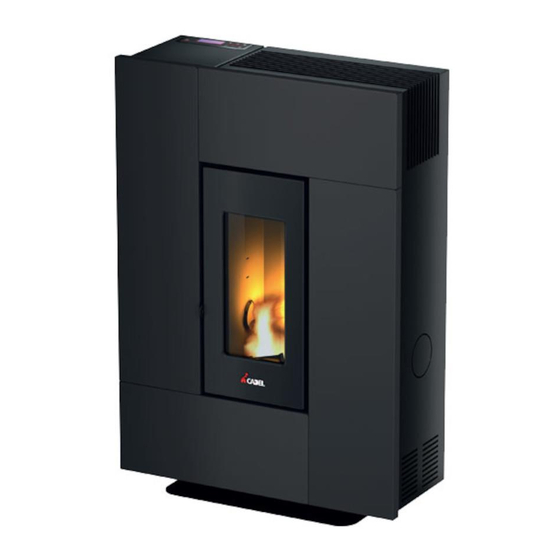
Summarization of Contents
Manual Simbology
Dear Customer
Greeting and introduction to the product, highlighting compliance with various standards.
Cautions
Important notes regarding the interpretation of images and potential issues.
Product Disposal Warnings
Electronic Waste Management
Guidelines for managing waste from electric and electronic appliances, including batteries and accumulators.
Product Use
Usage Introduction
Overview of instructions for optimal performance and lowest consumption during product use.
Control Panel Display
Explanation of the control panel display elements, status indicators, and functions.
Main Menu Navigation
Accessing and navigating through the main menu options like Time, Date, Timer, Sleep, Settings, and Info.
Settings Menu Configuration
Configuring operating modes, language, cleaning, loading, and other parameters via the settings menu.
Information Menu
Accessing system information such as product type, firmware version, total operating hours, and ignition counts.
Startup Procedure
Step-by-step guide for the initial startup, including technician checks and pre-heating phases.
Failed Ignition Troubleshooting
Diagnosing and resolving issues related to ignition failures, including ambient temperature effects and pellet quality.
Shutdown Procedure
Details on the automatic thermal shutdown phase, including fan operation and cooling processes.
Power Failure Handling
How the stove behaves during and after temporary power interruptions and blackouts.
Adjustments Menu
Setting room temperature, fan speed, and flame power levels for optimal comfort and efficiency.
Timer Programming
Setting up to six programmable timer programs for automatic start-up and shutdown schedules.
Timer Programming Examples
Illustrative examples of how to program the timer functions for different operating scenarios.
Auto Eco Mode
Activating and configuring the Auto Eco mode for energy saving based on room temperature or external thermostat.
Sleep Function
Setting a specific time for the product to automatically switch off, overriding timer settings if active.
Pellets Recipe Adjustment
Adapting the stove's operation to different pellet types by adjusting fuel consumption parameters.
Smoke Fan Speed Adjustment
Adjusting smoke expulsion speed to resolve installation issues like poor draught or clogging.
Fuel
Fuel Specifications
Recommended pellet features, quality standards, and the impact of using inadequate fuels.
Pellet Supply Procedure
Correct methods for supplying pellets, avoiding contact with hot surfaces and ensuring proper hopper closure.
Pellet Refuelling Timer
Information on the safety timer that activates if the pellet hopper door remains open for too long.
Ventilation
Details on the stove's ventilation system, air circulation, and precautions regarding air outlet slits.
Remote Control
Operating the stove using a remote control and its battery requirements.
Safety Devices and Alarms
Safety Devices Overview
Description of the safety devices integrated into the product for secure operation.
Pressure Switch Function
How the pressure switch monitors fume duct pressure and blocks pellet feed in specific situations.
Smoke Temperature Probe
Function of the smoke temperature probe in enabling or stopping operation based on temperature thresholds.
Fuel Hopper Thermostat
The role of the contact thermostat in the fuel hopper for immediate shutdown if safety temperature is exceeded.
Electrical Safety Features
Protection against current surges via main fuse and other fuses for electronic boards.
Smoke Fan Safety
Action taken by the electronic board if the smoke fan stops, including pellet supply shutdown and alarm.
Alarm Reset Procedure
Instructions on how to reset alarms by keeping the ESC button pressed and checking the warning cause.
Routine Maintenance
Routine Maintenance Introduction
Importance of periodic cleaning and maintenance for long working life, involving authorized technicians.
User Cleaning Tasks
Daily or weekly cleaning operations that the user can perform on the brazier and ash deposits.
Pre-Startup Cleaning
Essential cleaning steps before each startup to ensure optimal operation and prevent issues like clogging.
Hopper and Auger Cleaning
Checking and removing residue from the hopper bottom and auger, especially after pellet supply.
Annual Fume Pipe Cleaning
Annual cleaning of fume pipes, flue, and chimney pot by a specialized technician for efficiency and safety.
Glass Door Cleaning
Proper procedures for cleaning the fire door glass, emphasizing cool glass and avoiding thermal shocks.
In Case of Anomaly
Problem Solving Guide
A guide to identify and resolve common problems and anomalies encountered during product operation.

















Need help?
Do you have a question about the SPIRIT 3 and is the answer not in the manual?
Questions and answers